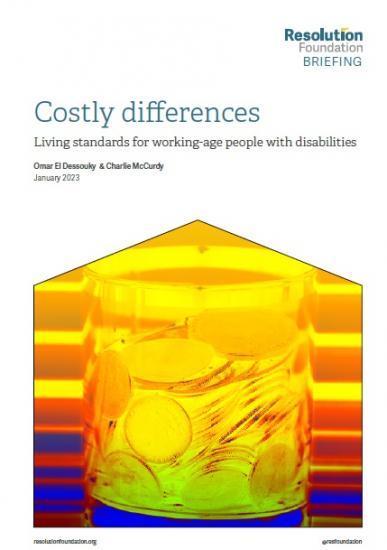Costly differences - Living standards for working-age people with disabilities
5th January 2023

The cost of living crisis has shone a harsh light on different groups' ability to deal with fast- rising prices. In this briefing note, we focus on the living standards of people with disabilities, including results from a new survey of just under 8,000 working-age adults. Over 2,000 reported a long-term illness or disability, to offer insight into their experience of the current crisis.
We focus on people with disabilities for two good reasons. First, disability is on the rise in Britain. The share of the working-age population with a disability has risen from 17 to 23 per cent since 2013, a rise of over 2.6 million people. Second, people with disabilities are more vulnerable to rising costs of essentials because energy and food make up a greater share of their budgets, on average, than for the non-disabled, in part because of additional needs caused by underlying health problems.
Key findings
The underlying disposable income gap between the disabled (£19,319) and non-disabled population (£27,766) was 44 per cent in 2020-21: down from 54 per cent a decade ago, but still hugely significant. This raw income gap excludes income from the extra-cost disability benefits, on the grounds that these are designed purely to offset additional costs associated with being disabled.
People with a disability are far more likely to be poor than the rest of the population. One-in-three (33 per cent) adults in the lowest household income decile have a disability, compared to fewer than one-in-ten (9 per cent) of adults in the highest household income decile.
Even after accounting for employment status, over half of the original income gap remains - showing that in-work disabled people face an increased risk of being on lower incomes too.
People with a disability are almost three times as likely to live in material deprivation than the rest of the population (34 per cent vs 13 per cent).
People with a disability have been stung by fast rising energy and food prices. Almost half (48 per cent) of disabled adults say they have had to cut back on energy use this winter, compared to almost one-third (32 per cent) of people without a disability.
Around two-fifths of people with a disability (41 per cent) said they couldn't afford to keep their homes warm, compared to under one-fifth (23 per cent) of the non-disabled population.
Almost one-in-three (31 per cent) people with a disability say they have had to reduce their expenditures on food, compared to 18 per cent of the non-disabled population.
Read the full report HERE
Pdf 20 pages.
